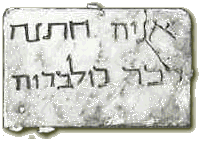| Catacombs: Archives of History
The epigraphy from the Roman catacombs has yielded the single largest corpus of information found to date concerning the daily life of the Jews and early Christians of ancient Rome. These inscriptions impart precious revelations of the civic, religious, and socioeconomic life of these communities.
The dominance of Greek epigraphy in the Jewish catacombs of Torlonia (greater than 90 percent), Monteverde (more than 75 percent), and in the other Jewish catacombs reflects the fact that Greek was the lingua franca of the Mediterranean at this time. The remaining epitaphs in the Jewish catacombs were in Latin, the principal tongue for the Christians by the mid-fourth century. One Aramaic inscription, one Aramaic-Greek epitaph (no. 47), and several stones with phrases in Hebrew or Semitic characters were found in the Monteverde burial grounds, perhaps this catacomb was the final resting place for those Roman Jews most conscious of their roots; whereas the Jews buried in the Randanini catacomb may have included the most Romanized considering the greater number of Latin epitaphs and Graeco-Roman symbols.
Although Greek was preferred in epigraphy, Latin names outnumbered Semitic and Greek names in the Judeo-Roman onomasticon. These facts might indicate the degree to which the Jews of ancient Rome had become integrated into the life of the Roman empire. While many Jews bore Latinized or Hellenized Semitic names, such as Gelasi(o)s and Hilaros for Isaac, Zosimos for Chayim, Theodotos for Jonathan, Iustus for Zadok, Donatus for Nathan, Aster for Esther, Irene for Shelomith, Regina for Malcah, only about 15 percent of their names were of direct Semitic origin. There appears to have been a greater use of Semitic names in the Monteverde catacomb. The inscriptions from the Monteverde catacomb cited hereafter were incised on marble and are located in the Musei Vaticani, Collezione Epigrafica Giudaica, unless otherwise indicated. |
 |

A Rare Instance of the Use of the Mother Tongue
24. This possible translation of a Hebrew-Aramaic inscription from the Monteverde catacomb has been widely discussed: "Annia, son-in-law of Bar-Colbruahh (or Calabria?)."
|